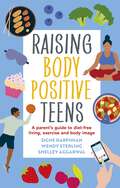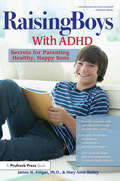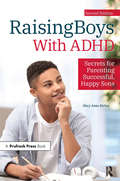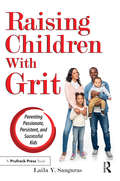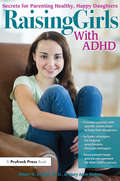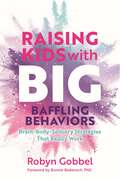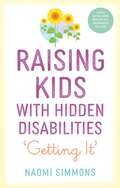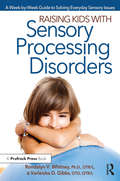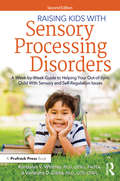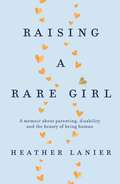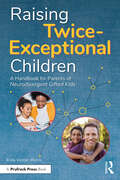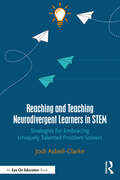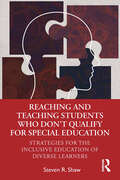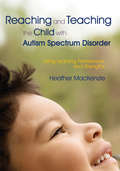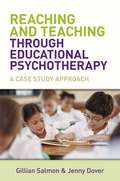- Table View
- List View
Raising Body Positive Teens: A Parent’s Guide to Diet-Free Living, Exercise, and Body Image
by Shelley Aggarwal Signe Darpinian Wendy SterlingIn a world fraught with diet-culture and weight stigma, many parents worry about their child's relationship with their body and food. This down-to-earth guide is an invaluable resource allowing parents to take proactive actions in promoting a friendship with food, and preventative actions to minimize the risk factors for the development of eating disorders, particularly when early signs of disordered eating, excessive exercise, or body dissatisfaction have been noticed. It provides clear strategies and tools with a practical focus to gently encourage parents and teens to have a healthy relationship with food and exercise by centralizing joy and health. Coming from a therapist, a dietician, and an adolescent medicine physician, with insightful case studies from an array of young people from different backgrounds, this multidisciplinary author team delivers friendly, strategic guidance based in a wealth of expertise.
Raising Boys With ADHD: Secrets for Parenting Healthy, Happy Sons
by James W. Forgan Mary Anne RicheyWritten by two professionals who have "been there and done that" with their own sons with ADHD, Raising Boys With ADHD empowers parents to help their sons with ADHD find success in school and beyond. The book covers topics not often found in other parenting guides such as the preschool years and early diagnosis and strategies for teens transitioning to work and college. Filled with practical knowledge, resources, and tools needed to help parents address the many strengths and challenges of boys with ADHD, this book provides parents with encouragement and hope for the future.
Raising Boys With ADHD: Secrets for Parenting Healthy, Happy Sons
by James W. Forgan Mary Anne RicheyWritten by two professionals who have "been there and done that" with their own sons with ADHD, Raising Boys With ADHD empowers parents to help their sons with ADHD find success in school and beyond. The book covers topics not often found in other parenting guides such as the preschool years and early diagnosis and strategies for teens transitioning to work and college. Filled with practical knowledge, resources, and tools needed to help parents address the many strengths and challenges of boys with ADHD, this book provides parents with encouragement and hope for the future.
Raising Boys With ADHD: Secrets for Parenting Successful, Happy Sons
by Mary Anne RicheyThe second edition of the best-selling Raising Boys With ADHD features the latest information on research and treatment for boys with ADHD. This book:Empowers parents to help their sons with ADHD find success in school and beyond.Covers topics not often found in other parenting guides.Provides a strength-based approach to helping boys discover their strengths and abilities.Helps boys become motivated, successful, and independent adults.Discusses the preschool years, early diagnosis, and strategies for teens transitioning to work and college.Filled with practical knowledge, a dynamic action planning guide, resources, and tools needed to help parents address the many strengths and challenges of boys with ADHD, this book provides parents with encouragement and hope for the future.
Raising Boys With ADHD: Secrets for Parenting Successful, Happy Sons
by Mary Anne RicheyThe second edition of the best-selling Raising Boys With ADHD features the latest information on research and treatment for boys with ADHD. This book:Empowers parents to help their sons with ADHD find success in school and beyond.Covers topics not often found in other parenting guides.Provides a strength-based approach to helping boys discover their strengths and abilities.Helps boys become motivated, successful, and independent adults.Discusses the preschool years, early diagnosis, and strategies for teens transitioning to work and college.Filled with practical knowledge, a dynamic action planning guide, resources, and tools needed to help parents address the many strengths and challenges of boys with ADHD, this book provides parents with encouragement and hope for the future.
Raising Children With Grit: Parenting Passionate, Persistent, and Successful Kids
by Laila SangurasGrit, the combination of passion and perseverance, has more of an influence on success than cognitive ability, and parents want nothing more than to raise happy, successful children. Raising Children With Grit: Parenting Passionate, Persistent, and Successful Kids provides the strategies that parents need to teach, motivate, and inspire children to pursue their passions with grit—and succeed. And by focusing on self-discipline, parenting strategies, and personality traits, parents can cultivate perseverance in their children. By coupling that with an emphasis on curiosity and interest-building activities, parents can help their children define their passions. Additionally, this book offers tips for parents about working with school personnel, how to model grit in their own lives, and how social factors can influence the development of grit.
Raising Children With Grit: Parenting Passionate, Persistent, and Successful Kids
by Laila SangurasGrit, the combination of passion and perseverance, has more of an influence on success than cognitive ability, and parents want nothing more than to raise happy, successful children. Raising Children With Grit: Parenting Passionate, Persistent, and Successful Kids provides the strategies that parents need to teach, motivate, and inspire children to pursue their passions with grit—and succeed. And by focusing on self-discipline, parenting strategies, and personality traits, parents can cultivate perseverance in their children. By coupling that with an emphasis on curiosity and interest-building activities, parents can help their children define their passions. Additionally, this book offers tips for parents about working with school personnel, how to model grit in their own lives, and how social factors can influence the development of grit.
Raising Girls With ADHD: Secrets for Parenting Healthy, Happy Daughters
by James W. Forgan Mary Anne RicheyAlthough an increasing number of girls are diagnosed with ADHD every year, most of the focus of parent and teacher interventions has been on boys, leaving girls with ADHD frustrated and prone to acting out. Written by two professionals who have “been there and done that” with their own children with ADHD, Raising Girls With ADHD provides expert information to empower parents to make decisions about identification, treatment options, behavioral strategies, personal/social adjustment, educational impact, and many other issues from preschool through high school. These girls' struggles with socialization and peer acceptance, executive functioning skills like memory and organization, and emotional well-being and self-confidence are discussed with a goal of maximizing strengths and providing supports for weaknesses. Complete self-reflection surveys and action steps for parents and girls alike are included to create a dynamic action plan for your daughter's success in school and beyond.
Raising Girls With ADHD: Secrets for Parenting Healthy, Happy Daughters
by James W. Forgan Mary Anne RicheyAlthough an increasing number of girls are diagnosed with ADHD every year, most of the focus of parent and teacher interventions has been on boys, leaving girls with ADHD frustrated and prone to acting out. Written by two professionals who have “been there and done that” with their own children with ADHD, Raising Girls With ADHD provides expert information to empower parents to make decisions about identification, treatment options, behavioral strategies, personal/social adjustment, educational impact, and many other issues from preschool through high school. These girls' struggles with socialization and peer acceptance, executive functioning skills like memory and organization, and emotional well-being and self-confidence are discussed with a goal of maximizing strengths and providing supports for weaknesses. Complete self-reflection surveys and action steps for parents and girls alike are included to create a dynamic action plan for your daughter's success in school and beyond.
Raising Kids with Big, Baffling Behaviors: Brain-Body-Sensory Strategies That Really Work
by Robyn Gobbel"All behavior makes sense"'"It most certainly does not!", is probably your first reaction.Parenting and neuroscience expert Robyn Gobbel is here to reveal how all behavior, no matter how baffling, can be explained and remedied. You just need to look past the behavior and understand what's going on inside.Robyn decodes the latest brain science into easy-to-understand principles and metaphors to help you become an expert in your child's behavior. She reveals simple ways to help you regulate and connect with your child, with brain-, body- and sensory-based strategies to overcome day-to-day challenges. She also provides you with the knowledge to understand and regulate your own brain so that you don't flip your lid when your child flips theirs.Let this be your lifeline for parenting or caring for any child with baffling behaviors and hidden challenges, including kids who have experienced adversity, or with additional needs.
Raising Kids with Hidden Disabilities: Getting It
by Naomi SimmonsWhen it comes to parenting a child with a hidden disability, everyone seems to have an opinion. Here, Naomi Simmons writes from experience, offering new solutions for when conventional parenting strategies just don't work.Whether it be high functioning autism, ADHD, OCD, a mood or anxiety disorder with or without a diagnosis, if you have a child with any hidden disability, this is the book for you. Naomi Simmons is a parent of children with a range of hidden disabilities. She provides candid guidance on how best to support children in this situation - dealing with meltdowns, school avoidance, self-harm, anxiety and depression - and shares the experiences of others who really do 'get it'. Addressing common concerns and hurdles, this book helps you respond to your child's needs and challenges while developing their unique strengths and talents.
Raising Kids With Sensory Processing Disorders: A Week-by-Week Guide to Solving Everyday Sensory Issues
by Rondalyn V Whitney Varleisha GibbsWhether it's having to remove tags from clothing or using special dimmed lighting when they study, kids with sensory disorders or special sensory needs often need adaptations in their everyday lives in order to find success in school and beyond. Taking a look at the most common sensory issues kids face, Raising Kids with Sensory Processing Disorders offers a compilation of unique, proven strategies parents can implement to help their children move beyond their sensory needs and increase their performance on tasks like homework, field trips, transitions between activities, bedtime, holidays, and interactions with friends. Written by a parent of two children with very different sensory needs, the book shows parents how to characterize their child's sensory issues into one of several profiles that they can then use to find the best adaptations and changes to their everyday routines.
Raising Kids With Sensory Processing Disorders: A Week-by-Week Guide to Solving Everyday Sensory Issues
by Rondalyn V Whitney Varleisha GibbsWhether it's having to remove tags from clothing or using special dimmed lighting when they study, kids with sensory disorders or special sensory needs often need adaptations in their everyday lives in order to find success in school and beyond. Taking a look at the most common sensory issues kids face, Raising Kids with Sensory Processing Disorders offers a compilation of unique, proven strategies parents can implement to help their children move beyond their sensory needs and increase their performance on tasks like homework, field trips, transitions between activities, bedtime, holidays, and interactions with friends. Written by a parent of two children with very different sensory needs, the book shows parents how to characterize their child's sensory issues into one of several profiles that they can then use to find the best adaptations and changes to their everyday routines.
Raising Kids With Sensory Processing Disorders: A Week-by-Week Guide to Helping Your Out-of-Sync Child With Sensory and Self-Regulation Issues
by Rondalyn V Whitney Varleisha Gibbs Rondalyn L. Whitney Varleisha Gibbs, OTD, OTR/LTaking a look at the most common sensory issues kids face, Raising Kids With Sensory Processing Disorders offers a compilation of unique, proven strategies that parents can implement to help their children move beyond their sensory needs. This updated second edition: Shows parents how to characterize their child's sensory issues into one of several profiles. Helps parents find the best adaptations and changes to their child's everyday routines. Provides a week-by-week series of activities and checklists. Helps improve children's performance on tasks like homework, transitions between activities, and interactions with friends. Is written by parents and occupational therapists. Whether it's having to remove tags from clothing or using special dimmed lighting when they study, kids with sensory disorders or special sensory needs often need adaptations in their everyday lives in order to find success in school and beyond.
Raising Kids With Sensory Processing Disorders: A Week-by-Week Guide to Helping Your Out-of-Sync Child With Sensory and Self-Regulation Issues
by Rondalyn V Whitney Varleisha Gibbs Rondalyn L. Whitney Varleisha Gibbs, OTD, OTR/LTaking a look at the most common sensory issues kids face, Raising Kids With Sensory Processing Disorders offers a compilation of unique, proven strategies that parents can implement to help their children move beyond their sensory needs. This updated second edition: Shows parents how to characterize their child's sensory issues into one of several profiles. Helps parents find the best adaptations and changes to their child's everyday routines. Provides a week-by-week series of activities and checklists. Helps improve children's performance on tasks like homework, transitions between activities, and interactions with friends. Is written by parents and occupational therapists. Whether it's having to remove tags from clothing or using special dimmed lighting when they study, kids with sensory disorders or special sensory needs often need adaptations in their everyday lives in order to find success in school and beyond.
Raising A Rare Girl: A memoir about parenting, disability and the beauty of being human
by Heather LanierAward-winning writer Heather Lanier's memoir about raising a child with a rare syndrome, defying the tyranny of normal, and embracing parenthood as a spiritual practice that breaks us open in the best of ways.Like many women of her generation, writer Heather Lanier did everything by the book when she was expecting her first child. She ate organic foods, recited affirmations and drew up a birth plan for an unmedicated labour in the hopes that she could create a SuperBaby, an ultra-healthy human destined for a high-achieving future.But her daughter Fiona challenged all of Lanier's preconceptions. Born with an ultra-rare syndrome known as Wolf-Hirschhorn, Fiona received a daunting prognosis: she would experience significant developmental delays and might not reach her second birthday. Not only had Lanier failed to produce a SuperBaby, she now fiercely loved a child that the world would sometimes reject. The diagnosis obliterated Lanier's perfectionist tendencies, along with her most closely held beliefs about certainty, vulnerability and love.With tiny bits of mozzarella cheese, a walker rolled to library story time, a talking iPad app and a whole lot of rock and reggae, mother and daughter spend their days doing whatever it takes to give Fiona nourishment, movement, and language. They also confront society's attitudes toward disability and the often cruel assumptions made about Fiona's worth. Lanier realises the biggest question is not, Will my daughter walk or talk? but, How can I best love my girl, just as she is?Loving Fiona opens Lanier up to new understandings of what it means to be human, what it takes to be a mother, and above all, the aching joy and wonder that come from embracing the unique life of her rare girl.
Raising Twice-Exceptional Children: A Handbook for Parents of Neurodivergent Gifted Kids
by Emily Kircher-MorrisJust because a child is gifted doesn't mean they don't have other types of neurodivergence, like ADHD, autism, dyslexia, and more. Conversely, even children with one of these diagnoses can be cognitively gifted. Raising Twice-Exceptional Children provides you with a road map to understand the complex make-up of your "gifted-plus," or twice-exceptional, child or teen. The book helps you understand your child's diagnosis, meet their social-emotional needs, build self-regulation skills and goal setting, and teach self-advocacy. It also shows you effective ways to collaborate with teachers and school staff, and it offers advice on finding strengths-based strategies that support development at home. For too long, these kids have fallen through the cracks. This book provides key information on how to best support neurodivergent children by leveraging their strengths while supporting their struggles.
Raising Twice-Exceptional Children: A Handbook for Parents of Neurodivergent Gifted Kids
by Emily Kircher-MorrisJust because a child is gifted doesn't mean they don't have other types of neurodivergence, like ADHD, autism, dyslexia, and more. Conversely, even children with one of these diagnoses can be cognitively gifted. Raising Twice-Exceptional Children provides you with a road map to understand the complex make-up of your "gifted-plus," or twice-exceptional, child or teen. The book helps you understand your child's diagnosis, meet their social-emotional needs, build self-regulation skills and goal setting, and teach self-advocacy. It also shows you effective ways to collaborate with teachers and school staff, and it offers advice on finding strengths-based strategies that support development at home. For too long, these kids have fallen through the cracks. This book provides key information on how to best support neurodivergent children by leveraging their strengths while supporting their struggles.
Reaching and Teaching Neurodivergent Learners in STEM: Strategies for Embracing Uniquely Talented Problem Solvers
by Jodi Asbell-ClarkeProviding salient stories and practical strategies, this book empowers educators to embrace the unique talents of neurodivergent learners in science, technology, engineering, and mathematics (STEM). An exploration of the exciting opportunities neurodiversity presents to build an innovative workforce is grounded in a large body of research from psychology, neuroscience, and education. Author Jodi Asbell-Clarke presents individual examples of neurodivergent journeys in STEM to establish evidence-based connections between neurodiversity and the types of innovative problem-solving skills needed in today’s workforce. The featured stories come directly from the author’s many years in inclusive classrooms with STEM teachers along with interviews from many neurodivergent professionals in STEM. Teachers will learn how to embrace the unique brilliance and potential of the neurodivergent learners in their classroom, working against historic marginalization and deficit-based perspectives of neurodiversity within the education system. Featuring illustrations of classroom-designed tools and materials alongside basic strategies to support executive function and emotion in learning, this book will help you nurture the talents of your neurodivergent learners and recognize their unique potential within STEM. Ideal for K-12 classroom teachers, special educators, learning specialists, psychologists, and school administrators.
Reaching and Teaching Neurodivergent Learners in STEM: Strategies for Embracing Uniquely Talented Problem Solvers
by Jodi Asbell-ClarkeProviding salient stories and practical strategies, this book empowers educators to embrace the unique talents of neurodivergent learners in science, technology, engineering, and mathematics (STEM). An exploration of the exciting opportunities neurodiversity presents to build an innovative workforce is grounded in a large body of research from psychology, neuroscience, and education. Author Jodi Asbell-Clarke presents individual examples of neurodivergent journeys in STEM to establish evidence-based connections between neurodiversity and the types of innovative problem-solving skills needed in today’s workforce. The featured stories come directly from the author’s many years in inclusive classrooms with STEM teachers along with interviews from many neurodivergent professionals in STEM. Teachers will learn how to embrace the unique brilliance and potential of the neurodivergent learners in their classroom, working against historic marginalization and deficit-based perspectives of neurodiversity within the education system. Featuring illustrations of classroom-designed tools and materials alongside basic strategies to support executive function and emotion in learning, this book will help you nurture the talents of your neurodivergent learners and recognize their unique potential within STEM. Ideal for K-12 classroom teachers, special educators, learning specialists, psychologists, and school administrators.
Reaching and Teaching Students Who Don’t Qualify for Special Education: Strategies for the Inclusive Education of Diverse Learners
by Steven R. ShawThis book helps readers understand, teach, and support children with persistent low academic achievement who don’t meet special education eligibility criteria, or for whom Tier 2 MTSS interventions are insufficient. Designed to be implemented in inclusive classrooms with minimal resources, comprehensive chapters cover topics from reading, writing, and math to executive functions, SEL, and mental health. This critical, ground-breaking volume provides teachers, psychologists, and counselors with an understanding of the issues children and adolescents with mild cognitive limitations and other causes of low academic achievement face, as well as detailed, evidence-based teaching practices to support their academic and social and emotional learning.
Reaching and Teaching Students Who Don’t Qualify for Special Education: Strategies for the Inclusive Education of Diverse Learners
by Steven R. ShawThis book helps readers understand, teach, and support children with persistent low academic achievement who don’t meet special education eligibility criteria, or for whom Tier 2 MTSS interventions are insufficient. Designed to be implemented in inclusive classrooms with minimal resources, comprehensive chapters cover topics from reading, writing, and math to executive functions, SEL, and mental health. This critical, ground-breaking volume provides teachers, psychologists, and counselors with an understanding of the issues children and adolescents with mild cognitive limitations and other causes of low academic achievement face, as well as detailed, evidence-based teaching practices to support their academic and social and emotional learning.
Reaching and Teaching the Child with Autism Spectrum Disorder: Using Learning Preferences and Strengths
by Heather MackenzieReaching and Teaching Children with Autism provides a positive approach to understanding and educating children on the autism spectrum. The book gives greater insight into the perspective and behavior of a child with autism and explores how the child's learning preferences, strengths and interests can be used to facilitate learning and enhance motivation. Based on well-researched theory and extensive clinical experience, the author provides a comprehensive model for developing lifelong independent learning skills in children with autism between the ages of 3 and 12 years old. The book describes the underlying principles, learning preferences and strengths typical of children with autism and offers a detailed but flexible program structure based on these concepts. Easy to follow activities and approaches are described in each chapter, along with clear examples and illustrations. This accessible and practical book is an essential resource for parents, teachers, support workers, therapists and others concerned with learning and development in children with autism.
Reaching and Teaching the Child with Autism Spectrum Disorder: Using Learning Preferences and Strengths (PDF)
by Heather MackenzieReaching and Teaching Children with Autism provides a positive approach to understanding and educating children on the autism spectrum. The book gives greater insight into the perspective and behavior of a child with autism and explores how the child's learning preferences, strengths and interests can be used to facilitate learning and enhance motivation. Based on well-researched theory and extensive clinical experience, the author provides a comprehensive model for developing lifelong independent learning skills in children with autism between the ages of 3 and 12 years old. The book describes the underlying principles, learning preferences and strengths typical of children with autism and offers a detailed but flexible program structure based on these concepts. Easy to follow activities and approaches are described in each chapter, along with clear examples and illustrations. This accessible and practical book is an essential resource for parents, teachers, support workers, therapists and others concerned with learning and development in children with autism.
Reaching and Teaching Through Educational Psychotherapy: A Case Study Approach
by Gillian Salmon Jenny DoverThis introduction to educational psychotherapy outlines the insights that will be of interest to teachers by discussing troubled children in the classroom who resist efforts to teach them. Its evidence-based approach allows teaching with confidence, and a clear understanding of the role of educational psychotherapy in the classroom. The book comprises four case studies of educational therapy work with children, chosen for their narrative interest and the variety of the children’s difficulties and backgrounds. As the stories of three boys and one girl unfold, the links between their learning difficulties and their social/emotional development become clear. Later chapters develop understanding of this way of working, with detailed accounts of how to assess suitability for educational therapy, psychoanalytic concepts underpinning the approach, and techniques and materials used in individual and classroom work.
